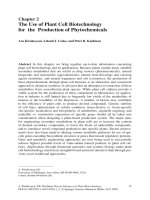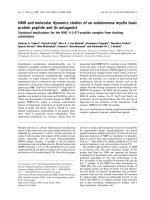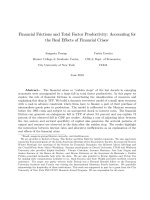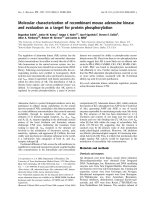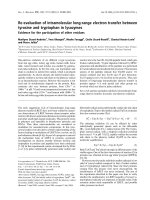Efficacy of in-vitro propagation among some advanced potato clones and evaluation of yield character for the production of nucleus seed
Bạn đang xem bản rút gọn của tài liệu. Xem và tải ngay bản đầy đủ của tài liệu tại đây (186.04 KB, 7 trang )
Int.J.Curr.Microbiol.App.Sci (2018) 7(7): 3481-3487
International Journal of Current Microbiology and Applied Sciences
ISSN: 2319-7706 Volume 7 Number 07 (2018)
Journal homepage:
Original Research Article
/>
Efficacy of in-vitro Propagation among Some Advanced Potato Clones and
Evaluation of Yield Character for the Production of Nucleus Seed
Naznin Sultana1, Md. Mosharraf Hossain Molla2, Ekramul Hoque1,
Shahinoor Rahman3*, Mashiur Rahman4 Ananya Prova5 and Abu Sayed6
1
Department of Biotechnology, Sher-e-Bangla Agricultural University, Dhaka, Bangladesh
2
Tuber Crop Research Center, Bangladesh Agricultural Research Institute,
Gazipur, Bangladesh
3
Department of Entomology, EXIM Bank Agricultural University, Bangladesh
4
Department of Chemical and Biochemical Engineering,
Technical University of Denmark, Denmark
5
Department of Plant Pathology, EXIM Bank Agricultural University Bangladesh
6
Department of Agricultural Engineering, EXIM Bank Agricultural University Bangladesh
*Corresponding author
ABSTRACT
Keywords
In vitro, Nucleus
seed, Potato clone,
Tissue culture,
Propagation,
minituber.
Article Info
Accepted:
26 June 2018
Available Online:
10 July 2018
This experiment was done to investigate in vitro propagation and nucleus seed production
efficiency of Bangladesh Agricultural Research Institute (BARI) developed clone potato
varieties. In vitro shoots of potato varieties BARI Alu-35, BARI Alu-36, BARI Alu-37,
BARI Alu-40, BARI Alu-46 and BARI Alu-62 were used as planting materials and BARI
Alu-7 was used as check variety. There was significant difference among the growth
parameters of in vitro plantlets of the potato varieties. The maximum number of leaf
(14.80), length of shoot (99.98cm) weight of fresh shoot (1.66 mg) was observed in BARI
Alu-36. The highest length of root (5.54 cm), maximum number of primary root (17.00),
number of secondary root (28.20) and fresh weight of root (0.359 mg) were observed in
BARI Alu-36. The variety BARI Alu-36 showed better performance on most of the
morphological traits under in vitro condition. On the other hand, survival percentage and
nucleus seed (G1 generation) production of potato have been done from virus free in vitro
plantlets of potato at net house. Maximum number and weight of G 1 seed tuber per plant is
52.4 and 358.0g respectively was recorded in the BARI Alu-46.
Introduction
Potato (Solanum tuberosum L.) is the most
important vegetable crop of Bangladesh. It
alone contributes to about 63% of the total
annual vegetable production in Bangladesh
(Islam, 2012). Total area under potato
cultivation is 4,62,032 hectares and total
potato production has been estimated
89,50,024 metric tons. Average yield of potato
has been estimated 19.371 metric tons per
hectare (BBS, 2014). Now potato stands as a
short duration winter crop in sub-tropical
countries like Bangladesh (Hossain, 2011).
Most of the varieties of potato have been
developed through ordinary selection and by
3481
Int.J.Curr.Microbiol.App.Sci (2018) 7(7): 3481-3487
conventional breeding which is very
prolonged procedure. Recently plant genetic
engineering techniques have been providing a
new opportunity for crop improvement. An
efficient tissue culture system is thought to be
crucial to the success of plant genetic
transformation. Transferring genes into plants
it is prerequisite to have efficient callus
induction and plantlet regeneration system
(Hamrick et al., 2000).
The regeneration of plants from cell and tissue
culture represent an essential component of
biotechnology and have the potentiality not
only to improve the existing cultivars, but also
for the generation of novel plants in a
comparatively short time compared to
conventional breeding (Khadiga et al.,
2009).The obtained tubers are small (1-25 g
wt.) and high quality commonly known as
mini tuber or nucleus seed. In vitro-produced
disease-free potato clones combined with
conventional multiplication methods have
become an integral part of seed production in
many countries (Naik and Sarkar, 2000).In
vitro regeneration of potato has been reported
from different explants on MS medium and
different growth regulators for diseases free
good quality plantlet or seed and pathogen
free planting materials (Hossain, 1994;
Rabbani et al., 2001; Zaman et al., 2001). in
vitro culture techniques and their practical
applications in clonal propagation, germplasm
storage, production of healthy virus-free plants
and breeding (Vinterhalter et al., 2011). Under
Bangladesh condition, very few reports are
available regarding the varietal effect and
explants on plantlet multiplication under in
vitro condition.
So, the present research is to provide the
information on high frequency plantlet
production to meet the producer demand as
well as morphological performances of
different varieties under in vivo condition.
Materials and Methods
The experiment was conducted during the
period from April 2016 to February 2017 to
investigate in vitro propagation and nucleus
seed (G1) production efficiency of Bangladesh
Agricultural Research Institute (BARI)
developed clone potato varieties. The
experiments were conducted at the laboratory
and net house of Tuber Crop Research Center
(TCRC), BARI, Gazipur. In laboratory
condition, Completely Randomized Design
(CRD) with three replications and in field
condition Randomized Complete Block
Design (RCBD) having three replications
were used.
Plant materials
The tuber of potato varieties BARI Alu-7,
BARI Alu-35, BARI Alu-36, BARI Alu-37,
BARI Alu-40, BARI Alu-46 and BARI Alu62 were used as plant materials for the
experiment. BARI Alu-7 has been used as
check variety. Stem segments having 2-3
nodes from in vitro plantlets were used for
micropropagation and determining IBA effect
on root production.
Culture media
Murashige and Skoog medium, Liquid
medium were used as culture medium for in
vitro regeneration.
Stock solutions preparation
The first step in the preparation of the medium
is the preparation of stock solutions of the
various constituents of the MS medium. As
different media constituents were required in
different concentrations, separate stock
solutions
for
the
macronutrients,
micronutrients, Fe-EDTA (Iron stock),
vitamins and growth regulators were prepared
separately for ready use. Other necessary
3482
Int.J.Curr.Microbiol.App.Sci (2018) 7(7): 3481-3487
solution like 1N NaOH, 70% ethanol,
preparation of MS media and Agar media and
all other necessary works were done by
maintaining proper guideline.
Preparation of explants, inoculation and
subculture
The shoot of potato was used as explants.
Disinfected shoots were then cut into small
segments and kept under sterilized distilled
water into sterilized petridishes to keep the
shoot alive. Explants were directly inoculated
to each vial containing 25 ml of MS liquid
medium. The vials were plugged crocked and
total operation was done in the laminar airflow
cabinet in sterile condition. The regenerated
plantlets were subcultured into semisolid
media after 7 days. The regenerated plantlets
were subcultured after 4 week of inoculation.
The shoot was cut into small pieces and placed
on prepared sterilized MS medium. The
subcultured vials were then inoculated at
25±10C with 16 h photo period. Repeated
subculture was attended at regular interval of
28 days.
Data collection
Data on the following parameters were
recorded under in vitro condition. Days
required for shoot and root appearance: Days
to well-developed shoot and root: Length of
the shoot or height of the plant (cm): Length
of the root (cm.): Number of leaves per
explant: Fresh and Dry weight of the shoot
and root (mg) was measured in mg by a digital
balance using following formula:
Fresh and Dry weight of root / shoot (mg) =
were kept in a shady condition without
removing the lids. The beds of the net house
were properly ploughed and were covered
with a mixture of sand, decomposed cow
dung, burnt rice husk and coconut dust
(1:1:1:1 v/v). The mixture was sterilized
properly to avoid damping off disease caused
by soil borne pathogens of the transplant.
After two weeks, the plantlets were
transplanted in beds under net house. Beds
were drenched with fungicides before
planting. Three to four water sprays were
given daily with a sprayer to keep the soil
moist and maintained humidity for initial one
week. Additional soil substrate was added on
the nursery beds to bury lower nodes. The
crop was allowed to mature and mini tubers
were harvested. Data on yield and yield
contributing characters were recorded. G1
generation seeds were kept in the cold storage
for using as a planting material in the next
crop season for breeder seed production.
Statistical analysis
The data obtained for different characteristics
were statistically analyzed to find out the
significance difference among the treatments.
The mean values of all the recorded
characteristics were evaluated and analysis of
variance was performed by the ‘F’ (variance
ratio) test using MSTAT-C software. The
significance of the difference among the
treatment means was estimated by Duncan’s
Multiple Range Test (DMRT) at 5% level of
probability.
Results and Discussion
In vitro propagation of BARI developed
clone potato varieties
Total weight of shoot/root
Days to shoot initiation
Total number of shoot/root measured
The plantlets (grown in vitro) about 6 cm
height were transferred to the net house and
Significant variation was observed among the
different varieties of potato on days to first
shoot initiation (Table 1). The maximum days
3483
Int.J.Curr.Microbiol.App.Sci (2018) 7(7): 3481-3487
to shoot initiation were recorded in BARI Alu7 (6.40 days) and BARI Alu- 35, BARI Alu36 and BARI Alu- 37 required minimum 6.00
days.
Days to root initiation
Significant variation was observed among
different variety of potato on days to first root
initiation (Table 2).
Number of leaf per plant
Number of leaf of potato varieties under study
varied significantly among each other (Table
1). The maximum number of leaf (14.80) was
recorded from BARI Alu- 36, which was
statistically identical. The minimum number
of leaf (6.20) was observed from BARI Alu7.
Length of shoot (cm)
Length of shoot of potato plantlet varied
significantly among the varieties under study
(Table 1). The highest length of shoot (9.98
cm) was recorded from BARI Alu- 36, while
the lowest length of shoot (3.76 cm) was
observed from BARI Alu- 7 which was
statistically similar to all variety except BARI
Alu- 36.
Fresh weight of shoot (mg)
Potato varieties were influenced by the fresh
weight of shoot. The maximum weight of
fresh shoot (1.669 mg) was observed in BARI
Alu- 36 and the minimum weight (0.096 mg)
was found in BARI Alu- 7 (Table 1).
Dry weight per plant (mg)
The dry weight of shoot was not significantly
influenced by variety of potato. The maximum
dry weight per plant (0.00922 mg) was
observed in BARI Alu- 36 and the minimum
dry weight (0.00572 mg) was observed in
BARI Alu- 7 (Table 1).
From table 1 we can conclude that, BARI Alu36 perform better in contrast of other clones of
potato variety.
The maximum days to root initiation were
recorded in BARI Alu- 7 (5.8 days) and BARI
Alu- 36 required minimum 3.80 days.
Length of root (cm)
Length of root of potato plantlet varied
significantly among the varieties under study
(Table 2). The highest length of root (5.54 cm)
was recorded from BARI Alu- 36, while the
lowest length of shoot (1.50 cm) was observed
from BARI Alu- 7 which was statistically
similar with BARI Alu- 35.
Number of primary root
Number of primary root was significantly
influenced by varieties under study (Table 2).
The maximum number of primary root (17.00)
was recorded from BARI Alu- 36, which was
statistically identical. The minimum number
of leaf (10.40) was observed from BARI Alu7.
Number of secondary root
Number of secondary root varied significantly
for different variety (Table 2). The highest
number of secondary root (28.20) was
recorded from BARI Alu- 36, whereas the
lowest number of secondary root (0.6) was
found from BARI Alu- 7.
Fresh weight of root (mg)
Potato variety significantly influenced the
fresh weight of root. The maximum weight of
fresh root (0.359 mg) was observed in BARI
Alu- 36 and the minimum weight (0.089mg)
was found in BARI Alu- 7 (Table 2).
Dry weight of root per plant (mg)
3484
Int.J.Curr.Microbiol.App.Sci (2018) 7(7): 3481-3487
The dry weight of root per plant was
significantly influenced by variety of potato.
The maximum dry weight of root per plant
(0.00112mg) was observed in BARI Alu- 36
and the minimum dry weight of root
(0.00402mg) was observed in BARI Alu- 7
(Table 2).
From table 2, we make a decision that,
considering all of the parameter, BARI Alu36 are the best clone among all other potato
varieties of Bangladesh.
Evaluation of nucleus seed production
among BARI developed clone potato
varieties
Plant height (cm)
Plant height of seven potato varieties varied
significantly under net house conditions
(Table 3). The tallest plants (86.73 cm) were
recorded in BARI Alu- 46 followed by BARI
Alu-40 (77.43). There was no significant
difference between the variety BARI Alu- 7
and BARI Alu- 35. The shortest plant (cm)
was observed in BARI Alu- 35.
Number of shoot per plant
Number of shoot per plant of potato varied
significantly for different varieties (Table 3).
The highest number of shoot per plant (9.00)
was recorded from potato variety BARI Alu35. The lowest number of shoot per plant
(1.20) was found from BARI Alu- 37. Number
of shoot per plant produced by BARI Alu- 7
and BARI Alu- 62 was statistically identical
(Table 3).
Number of leaf per plant
Significant variation was observed among the
different varieties of potato on number of leaf
per plant (Table 3). The maximum number of
leaves per plant (134.50) was recorded from
potato variety BARI Alu- 35. The lowest
number of leaf per plant (23.13) was found
from BARI Alu- 36 which was statistically
similar with BARI Alu- 37.
Table.1 Effect on varieties on days to shoot initiation, number of leaf per plant, shoot length,
fresh and dry weight of the shoot of potato
Treatment
BARI Alu- 7
BARI Alu- 35
BARI Alu- 36
BARI Alu- 37
BARI Alu- 40
BARI Alu- 46
BARI Alu- 62
LSD (0.05)
CV (%)
Days to shoot
initiation
6.80 a
6.00 b
6.00 b
6.00 b
6.60 a
6.40 ab
6.40 ab
0.53
6.47
No. of
leaf/plant
6.20 d
10.20 bc
14.80 a
13.20 ab
9.80 c
12.00 abc
12.00 abc
3.04
10.85
Shoot length
(cm)
3.76 b
4.70 b
9.98 a
4.56 b
4.22 b
4.20 b
4.24 b
1.33
7.84
3485
Fresh weight of
shoot (mg)
0.09552 b
0.79900 b
1.66900 a
0.67110 b
0.12160 b
0.68270 b
0.20310 b
0.71140
9.86000
Dry weight of
shoot (mg)
0.00572 a
0.00624 a
0.00922 a
0.00822 a
0.00842 a
0.00908 a
0.00642 a
0.00413
9.98000
Int.J.Curr.Microbiol.App.Sci (2018) 7(7): 3481-3487
Table.2 Effect of varieties on days to root initiation, root length, no. of primary and secondary
root per plant, fresh and dry weight of root per plant of potato
Treatment
Days to
root
initiation
Root
length
(cm)
No. of
primary
root/plant
No. of
secondary
root/plant
Fresh weight
of root (mg)
Dry
weight of
root (mg)
BARI Alu- 7
5.80 a
1.80 c
10.40 b
0.60 c
0.0895 b
0.0040 c
BARI Alu- 35
4.20 bc
1.82 c
12.80 ab
7.80 b
0.1941 ab
0.0073 abc
BARI Alu- 36
3.80 c
5.54 a
17.00 a
28.20 a
0.3591 a
0.0112 a
BARI Alu- 37
4.00 c
3.02 b
13.80 ab
3.60 c
0.2874 ab
0.0090 ab
BARI Alu- 40
5.00 ab
2.36 bc
14.00 ab
6.60 b
0.1282 ab
0.0046 bc
BARI Alu- 46
5.80 a
2.12 bc
12.80 ab
2.60 c
0.1064 ab
0.0063 bc
BARI Alu- 62
4.00 c
2.94 b
15.00 ab
0.80 c
0.2864 ab
0.0033 c
LSD (0.05)
0.8619
1.018
5.276
2.862
0.2261
0.0041
CV (%)
6.47
4.79
9.53
10.61
8.7500
10.0900
Table.3 Effect of varieties on plant height, number of shoot, leaf, tuber and weight of
tuber per plant
Treatment
BARI Alu- 7
BARI Alu- 35
BARI Alu- 36
BARI Alu- 37
BARI Alu- 40
BARI Alu- 46
BARI Alu- 62
LSD (0.05)
CV(%)
Plant height
(cm)
65.33 d
65.53 d
51.53 f
57.73 e
77.53 b
86.73 a
68.40 c
1.98
7.65
No. of
shoot/plant
4.20 d
9.00 a
2.40 e
1.20 f
5.00 c
5.40 b
4.00 d
0.23
8.81
No. of
leaf/plant
74.73 d
134.50 a
23.13 f
23.33 f
88.13 b
85.53 c
59.13 e
1.97
7.59
No. of
tuber/plant
21.20d
37.40b
16.00g
18.60f
30.40c
52.40a
19.40e
0.22
6.45
Weight of
tuber/plant
307.30b
142.30f
195.50d
114.70g
182.70e
358.30a
256.90c
2.83
5.71
tuber (18.60) was found from BARI Alu- 37.
Weight of tuber
Number of tubers per plant
Number of tuber per plant varied significantly
in different varieties under study (Table 3).
The highest number of tuber (52.40) was
recorded from BARI Alu- 46 followed by
37.40 in BARI Alu-40.The lowest number of
Average weight of tuber varied significantly
for different in varieties at net house condition
(Table 3). The maximum weight of tuber
(358.30g) was recorded from BARI Alu- 46.
3486
Int.J.Curr.Microbiol.App.Sci (2018) 7(7): 3481-3487
The minimum average weight of tuber
(142.30 g) was found from BARI Alu- 35.
From the table 3, it’s clear that BARI Alu- 46
perform best among other contrasting potato
clones, so this variety may the suitable for the
production of nucleus seed.
Based on the results and discussion it can be
concluded that the variety BARI Alu-36
showed better performance (Number of leaf,
length of shot, weight of fresh root, length of
root, maximum number of primary root,
number of secondary root and fresh weight of
root) under in vitro condition.Growth,
development and yield of G1 seeds/minituber
per plant was found better in BARI Alu- 46.
References
BBS (Bangladesh Bureau of Statistics), 2014.
Yearbook of Agricultural Statistics in
Bangladesh, Bangladesh Bureau of
Statistics,
Ministry
of
Planning,
Government of the People’s Republic of
Bangladesh.
Hamrick, J.L. and Godt., M.J. 2000. Allozyme
diversity in plant species. In: Plant
Population Genetics, Breeding and Genetic
Resources eds. Brown AHD, Clegg MT,
Kahler AL, Weir BS., pp. 43-63.
Hossain, M.J. 1994. In vitro propagation of
potato Solanum tuberosum L. J. Plant
Tissue Cult., 4(1):33-37.
Hossain, M.S. 2011. Yield potential, storage
behavior and degeneration of potato
varieties in Bangladesh. Ph.D. thesis,
Bangabandhu Sheikh Mujibur Rahman
Agricultural University, Gazipur-1706,
Bangladesh.
Islam, M.R. 2012. Performance studies of
twenty-four potato accessions under
Mymensingh condition. M.Sc. Thesis,
Bangladesh
Agricultural
University
Mymensingh, Bangladesh.
Khadiga, G., Elaleem, A., Modawi, R.S. and
Khalafalla, M.M. 2009. Effect of Cultivar
and Growth Regulator on In vitro
Micropropagation of Potato Solanum
tuberosum L. American-Eurasian J.
Sustainable Agric., 3(3): 487-492.
Naik P Sand Sarkar D. 2000. In vitro
propagation and conservation of genetic
resources in potato. In: Biotechnology in
Horticultural and Plantation Crops
(Chadha K L, Ravindran P N and Sahijram
Leela, eds.), pp. 369-406. Malhotra
Publishing House, New Delhi.
Rabbani, A., Askari, B., Abbasi, N.A., Bhatti,
M. and Quraishi, A. 2001. Effect of shoot
regeneration in Triticum aestivum and
Nicotiana plumbaginifolia tissue cultures
using the ethylene inhibitor silver nitrate.
Plant Cell Reports.6(1): 1-4.
Vinterhalter, D., Dragićević, I. and Vinterhalter,
B. 2011. Potato in vitro Culture
Techniques and Biotechnology. Fruit,
Vegetable and Cereal Sci. and Biotech.,
1(2): 16-45 (Special Issue).
Zaman, M.S., Quershi, A., Hasan, G., Din,
R.U., Ali, S., Khabir, A. and Gul, N. 2001.
Meristem culture of potato Solanum
tuberosum L. for production of virus free
plantlets, Online J. Bio. Sci., 1: 898-899.
How to cite this article:
Naznin Sultana, Md. Mosharraf Hossain Molla, Ekramul Hoque, Shahinoor Rahman, Mashiur
Rahman, Ananya Prova and Abu Sayed. 2018. Efficacy of in-vitro Propagation among Some
Advanced Potato Clones and Evaluation of Yield Character for the Production of Nucleus
Seed. Int.J.Curr.Microbiol.App.Sci. 7(07): 3481-3487.
doi: />
3487
